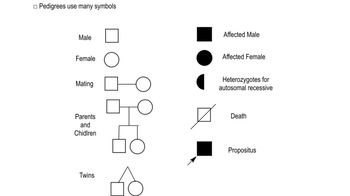Table of contents
- 1. Introduction to Genetics51m
- 2. Mendel's Laws of Inheritance3h 37m
- 3. Extensions to Mendelian Inheritance2h 41m
- 4. Genetic Mapping and Linkage2h 28m
- 5. Genetics of Bacteria and Viruses1h 21m
- 6. Chromosomal Variation1h 48m
- 7. DNA and Chromosome Structure56m
- 8. DNA Replication1h 10m
- 9. Mitosis and Meiosis1h 34m
- 10. Transcription1h 0m
- 11. Translation58m
- 12. Gene Regulation in Prokaryotes1h 19m
- 13. Gene Regulation in Eukaryotes44m
- 14. Genetic Control of Development44m
- 15. Genomes and Genomics1h 50m
- 16. Transposable Elements47m
- 17. Mutation, Repair, and Recombination1h 6m
- 18. Molecular Genetic Tools19m
- 19. Cancer Genetics29m
- 20. Quantitative Genetics1h 26m
- 21. Population Genetics50m
- 22. Evolutionary Genetics29m
2. Mendel's Laws of Inheritance
Pedigrees
Problem 24
Textbook Question
A 'wrongful birth' case was recently brought before a court in which a child with Smith–Lemli–Opitz syndrome was born to apparently healthy parents. This syndrome is characterized by a cluster of birth defects including cleft palate, and an array of problems with the reproductive and urinary organs. Originally considered by their physician as having a nongenetic basis, the parents decided to have another child, who was also born with Smith–Lemli–Opitz syndrome. In the role of a genetic counselor, instruct the court about what occurred, including the probability of the parents having two affected offspring, knowing that the disorder is inherited as a recessive trait.
 Verified step by step guidance
Verified step by step guidance1
Step 1: Explain the inheritance pattern of Smith–Lemli–Opitz syndrome, which is an autosomal recessive disorder. This means that both parents must be carriers of the recessive allele for the child to be affected.
Step 2: Define what it means to be a carrier. A carrier has one normal allele and one mutated allele but does not exhibit symptoms of the disorder.
Step 3: Use a Punnett square to illustrate the genetic cross between two carrier parents. Each parent has a 50% chance of passing on the normal allele and a 50% chance of passing on the mutated allele.
Step 4: Calculate the probability of the offspring being affected. For each child, there is a 25% chance (1 in 4) of inheriting two mutated alleles, resulting in the disorder.
Step 5: Determine the probability of having two affected children. Since each child's genotype is an independent event, multiply the probabilities of each child being affected (0.25 * 0.25) to find the probability of both children being affected.
Recommended similar problem, with video answer:
 Verified Solution
Verified SolutionThis video solution was recommended by our tutors as helpful for the problem above
Video duration:
2mPlay a video:
Was this helpful?
Key Concepts
Here are the essential concepts you must grasp in order to answer the question correctly.
Recessive Inheritance
Recessive inheritance refers to a pattern of genetic transmission where two copies of a mutated gene (one from each parent) are necessary for an individual to express a particular trait or disorder. In the case of Smith–Lemli–Opitz syndrome, which is inherited as a recessive trait, both parents must be carriers of the mutated gene for their child to be affected. If both parents are carriers, there is a 25% chance with each pregnancy that their child will inherit the disorder.
Recommended video:
Guided course

Organelle Inheritance
Carrier Status
Carrier status indicates that an individual possesses one copy of a mutated gene but does not exhibit symptoms of the associated disorder. In the context of Smith–Lemli–Opitz syndrome, both parents may be asymptomatic carriers, meaning they can pass the mutated gene to their offspring without being affected themselves. Understanding carrier status is crucial for genetic counseling, as it helps assess the risk of having affected children.
Recommended video:
Guided course

Sex-Linked Pedigrees
Genetic Counseling
Genetic counseling is a process that provides individuals and families with information about genetic conditions, including risks, inheritance patterns, and implications for future pregnancies. In this case, a genetic counselor would explain the likelihood of the parents having another child with Smith–Lemli–Opitz syndrome, emphasizing the 25% recurrence risk due to the recessive nature of the disorder. This counseling helps families make informed decisions regarding family planning and understanding their genetic health.
Recommended video:
Guided course

Descriptive Genetics

 2:48m
2:48mWatch next
Master Pedigree Symbols with a bite sized video explanation from Kylia Goodner
Start learning



